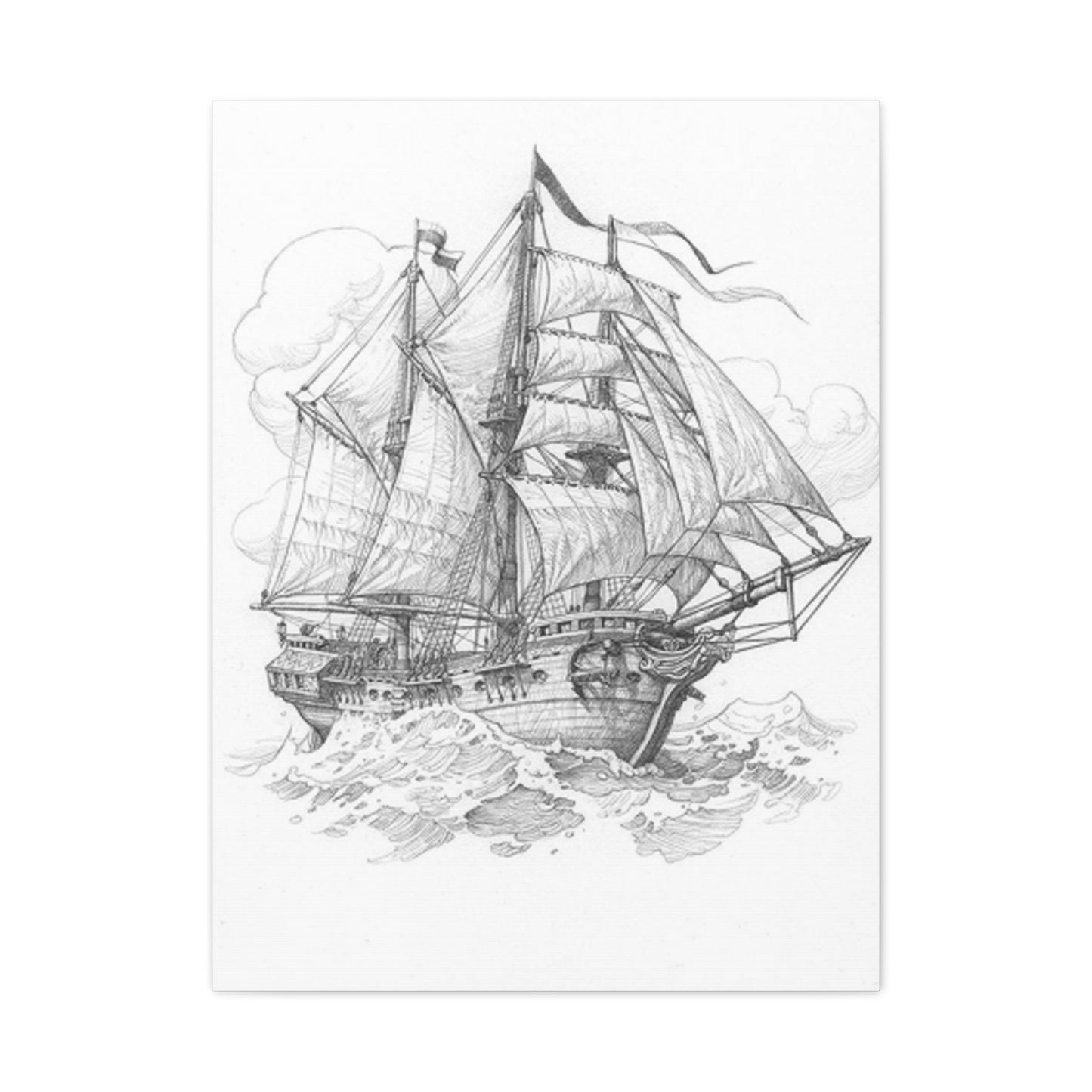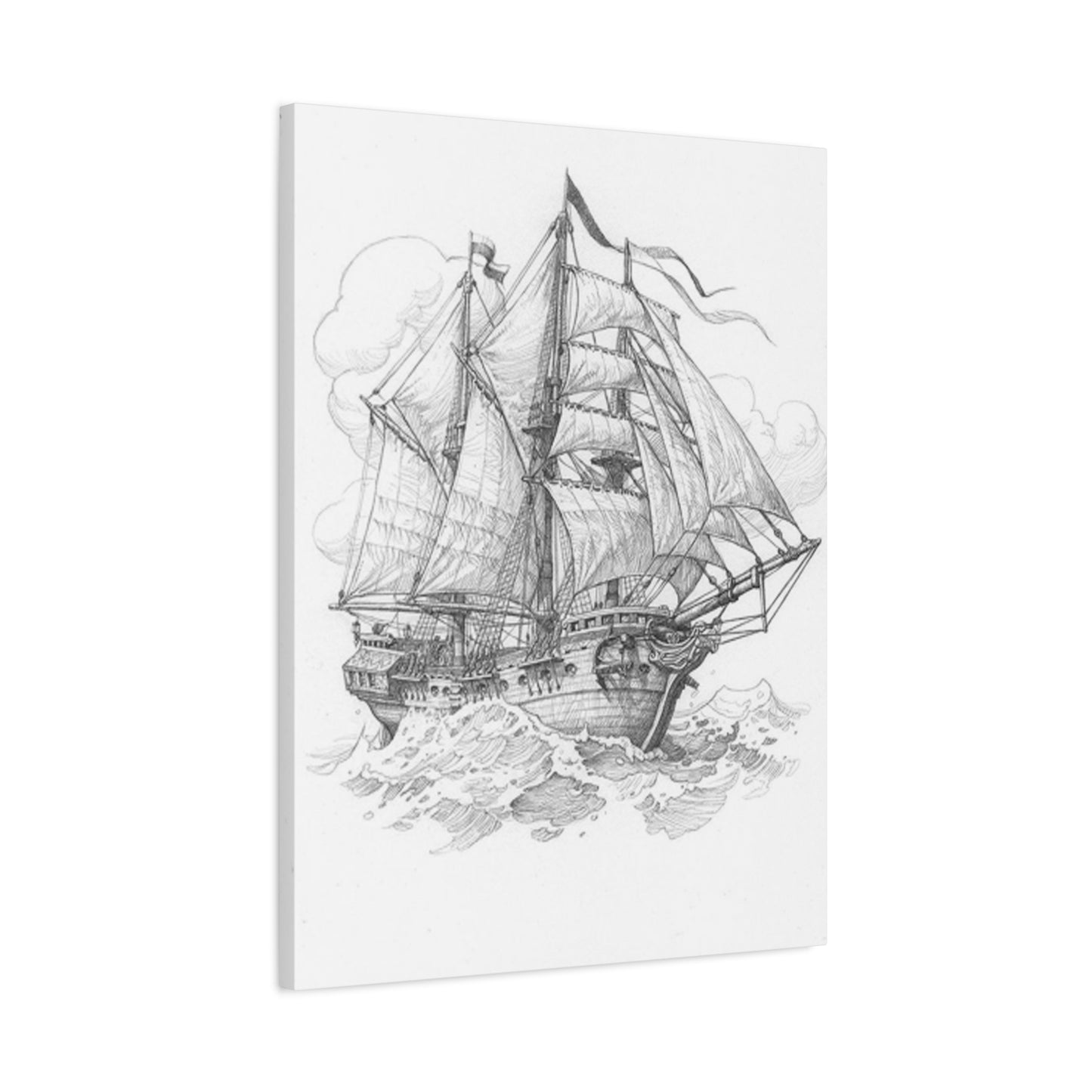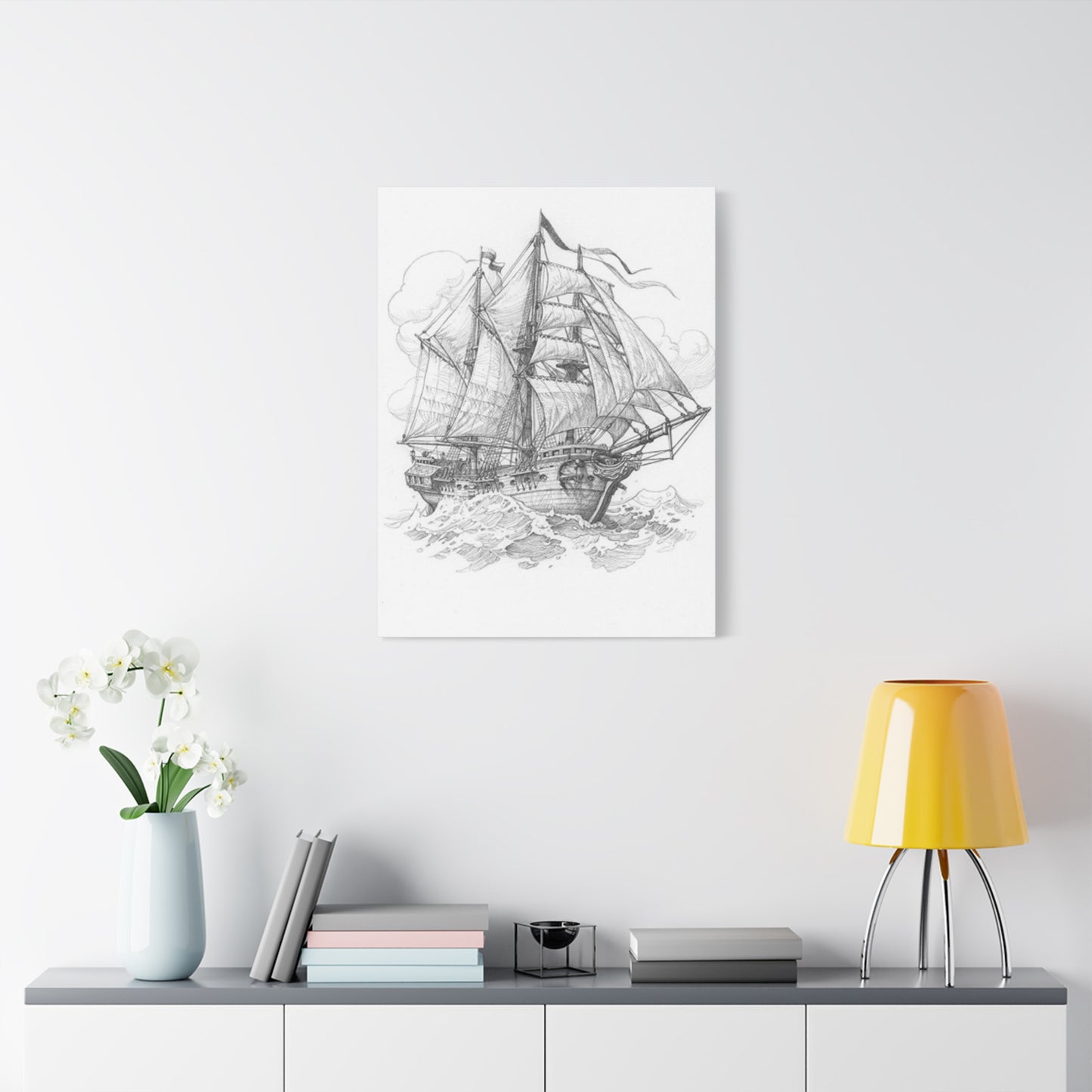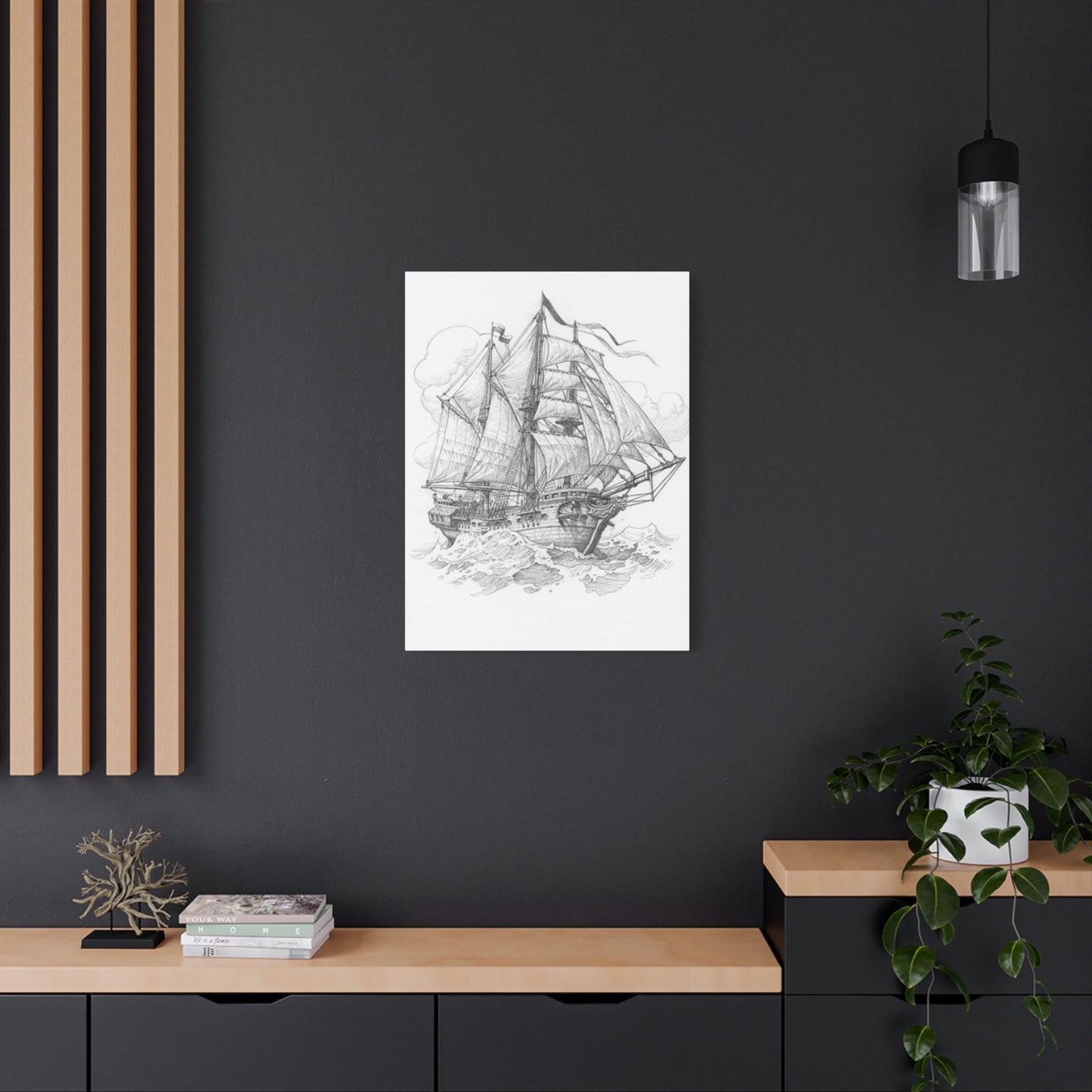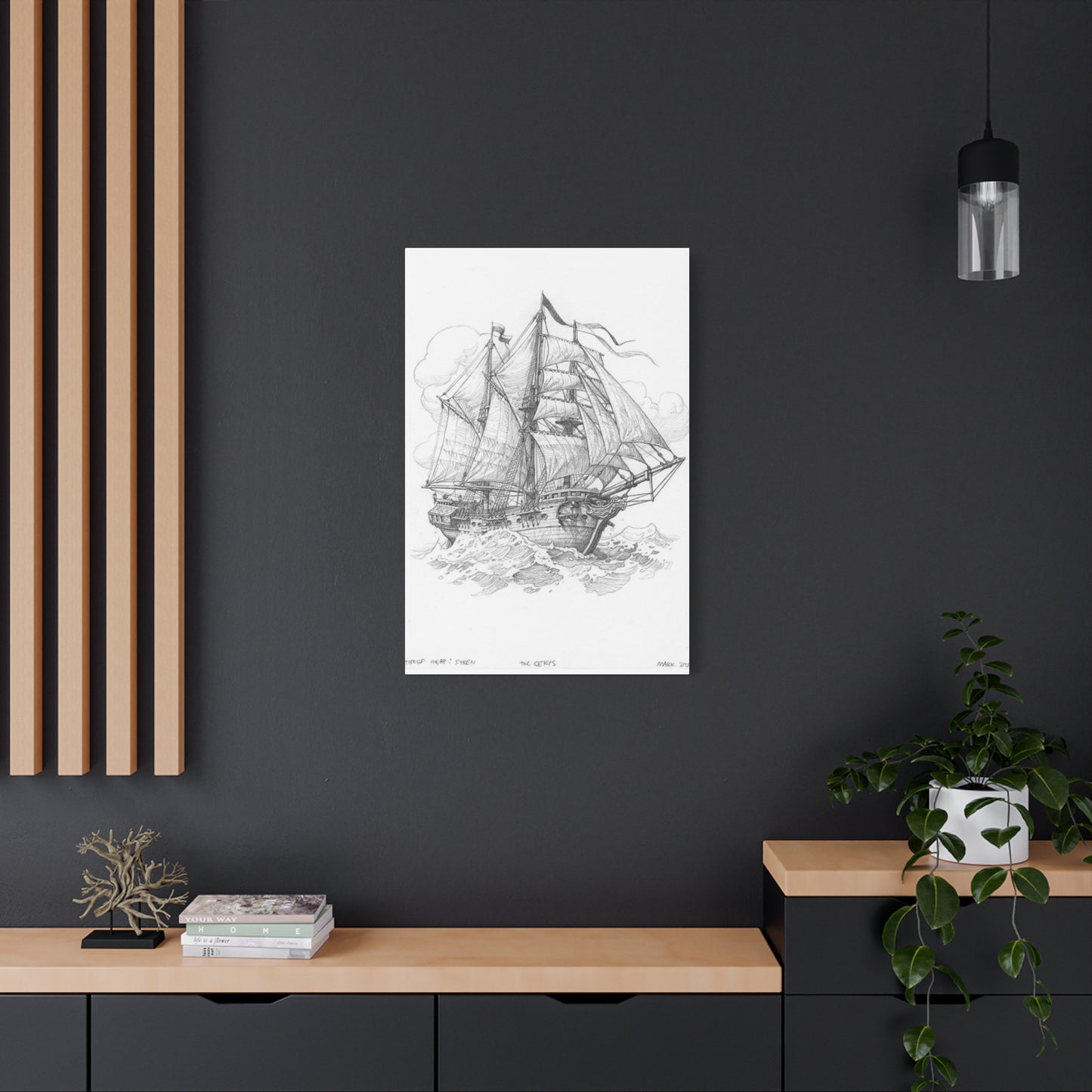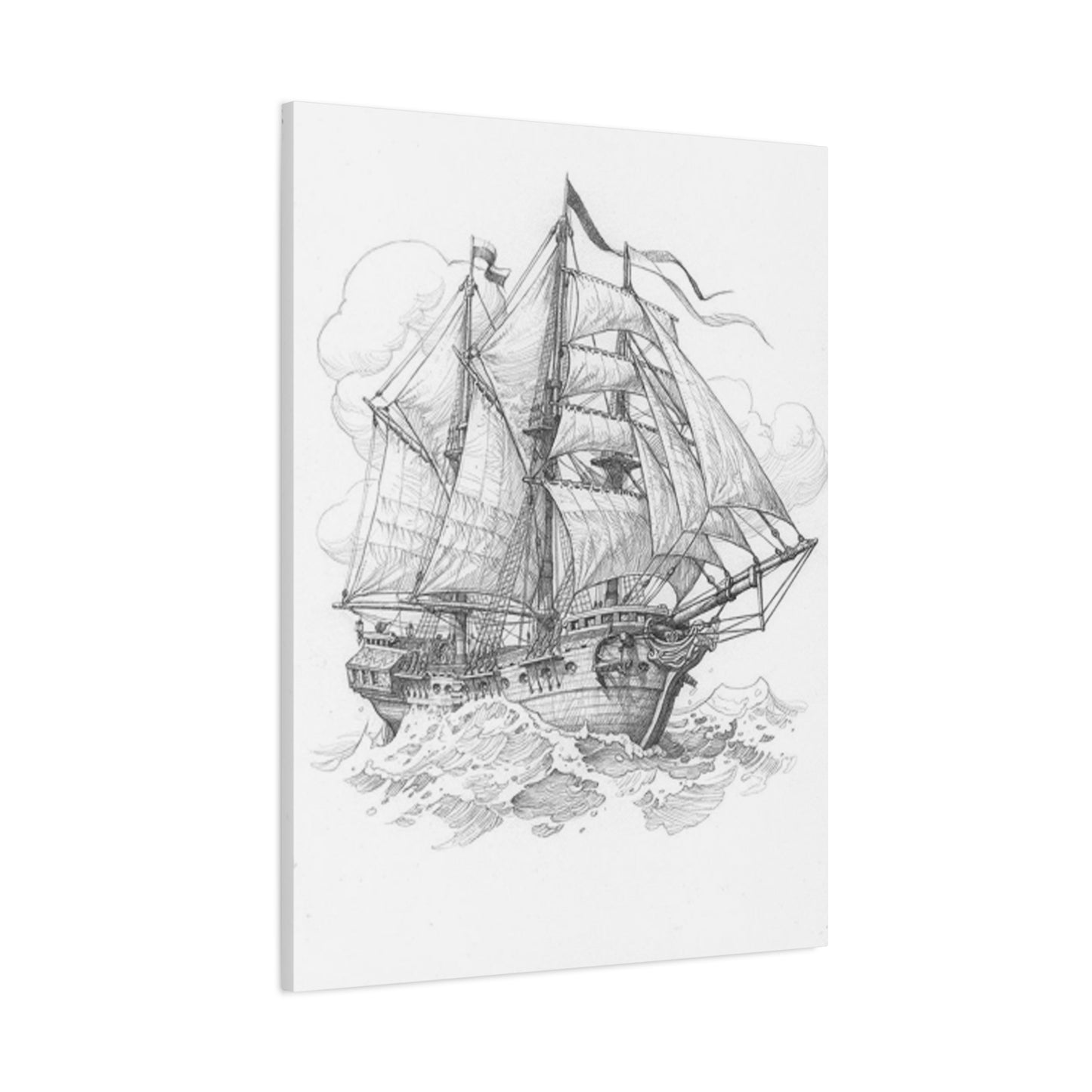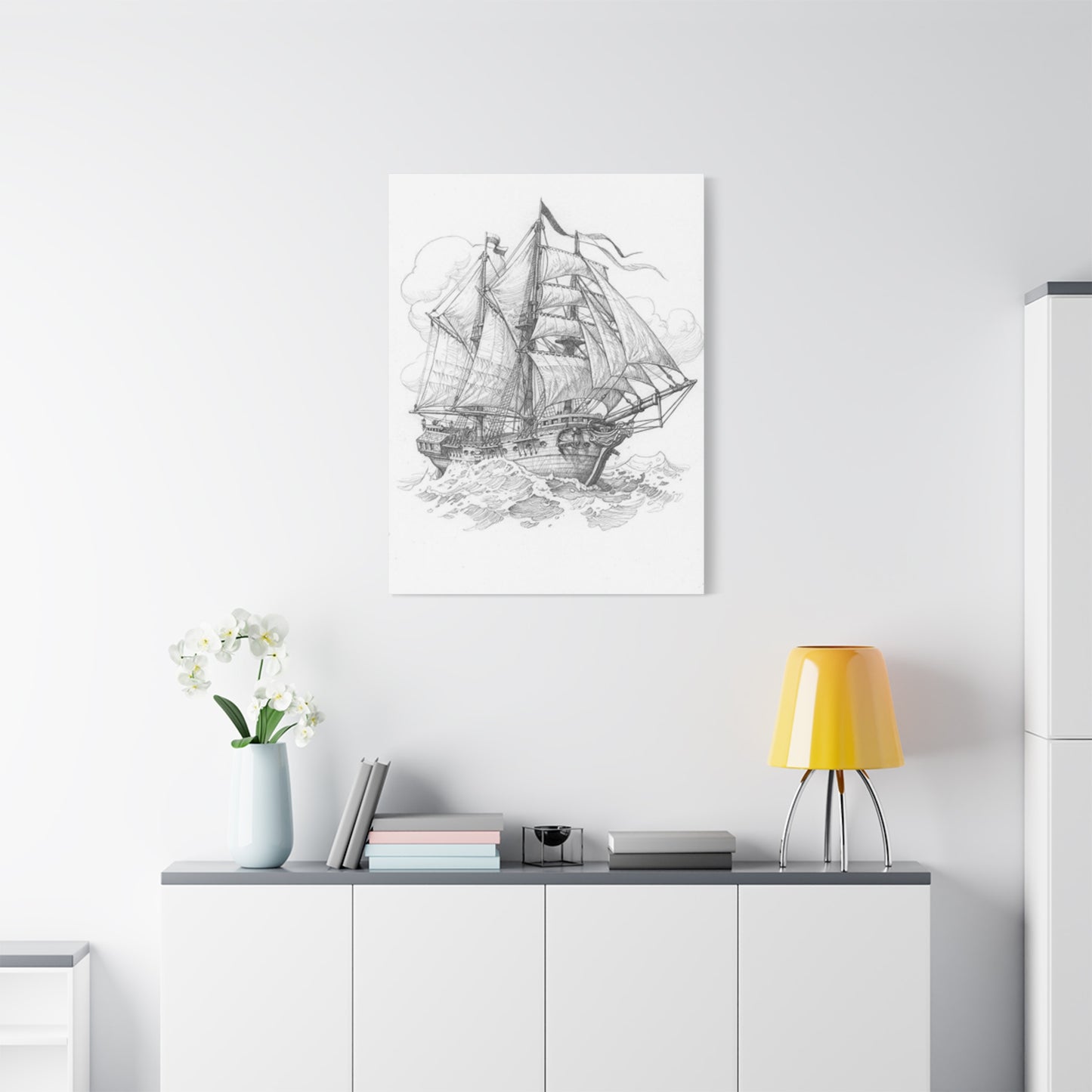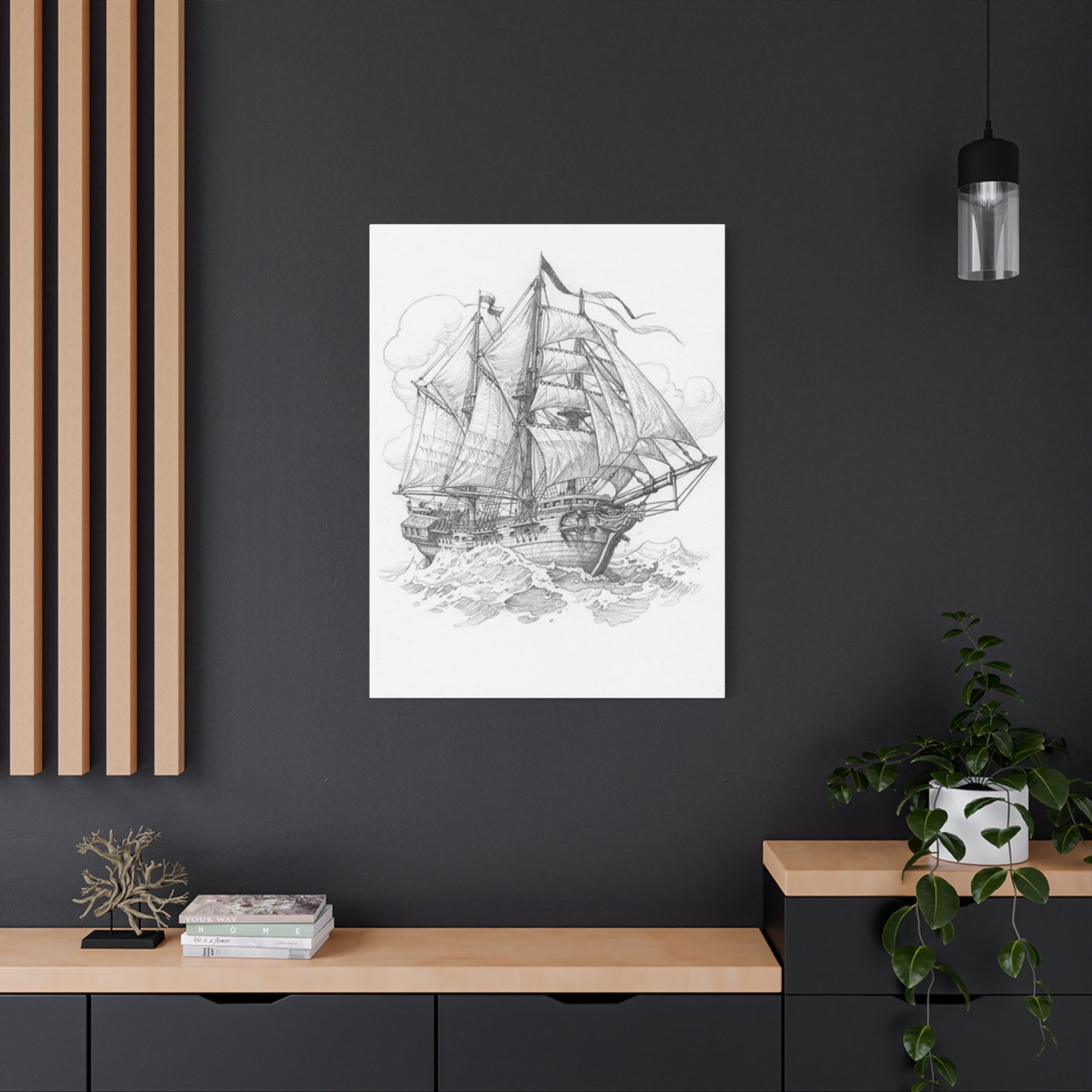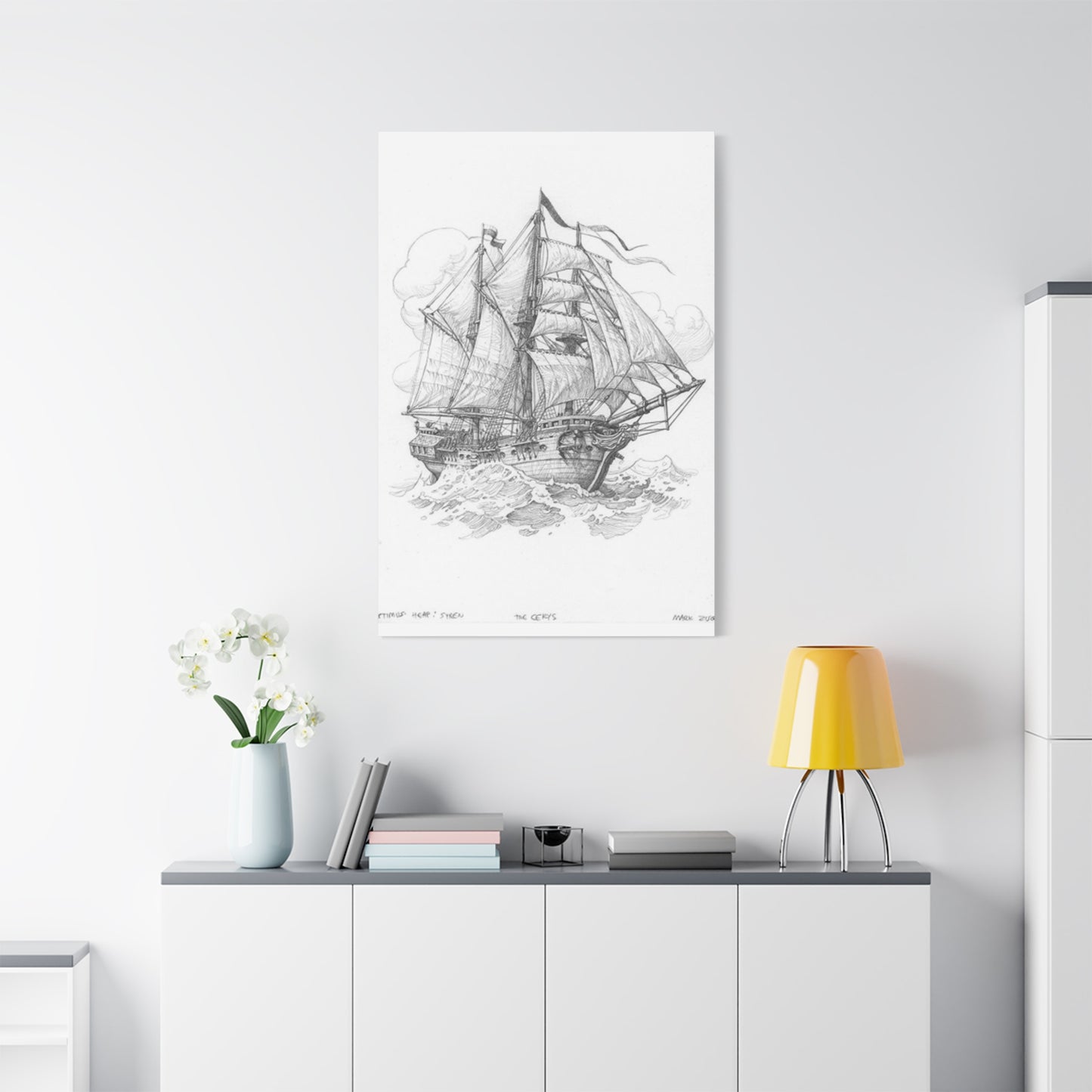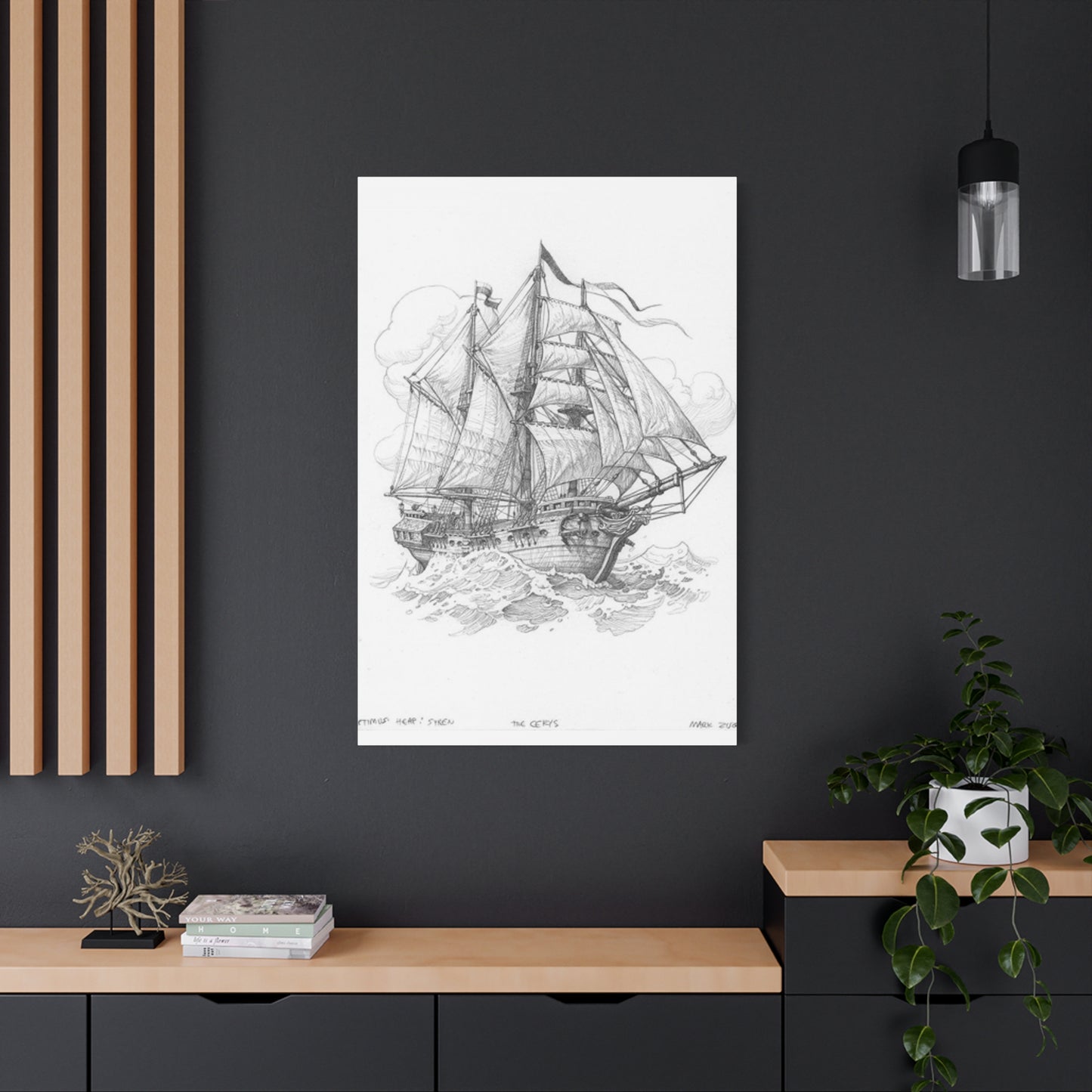Sailing the Seas: Detailed Ship Drawing Wall Art to Inspire Adventure
Maritime artwork has captivated collectors and homeowners for centuries, bringing the romance of ocean voyages and seafaring adventures into living spaces. The timeless appeal of sailing vessels rendered in artistic form creates an atmosphere of sophistication and wanderlust that few decorative elements can match. Whether displayed in coastal residences or urban apartments, these pieces transform ordinary walls into windows overlooking distant horizons and forgotten voyages.
The enduring popularity of ship-themed artwork stems from humanity's deep connection to the sea. Throughout history, sailing vessels represented exploration, commerce, and the human spirit's determination to venture beyond known boundaries. Today, artistic representations of these magnificent crafts serve as reminders of that bold heritage while adding visual interest and narrative depth to interior spaces.
Modern interpretations range from faithful historical reproductions to abstract contemporary expressions, ensuring options exist for every aesthetic preference. The versatility of ship illustrations allows them to complement diverse design schemes, from traditional nautical themes to minimalist contemporary settings. Collectors appreciate both the artistic merit and the storytelling potential these pieces offer, making them conversation starters and focal points in any room.
Refined Line Drawings of Sailing Vessels for Sophisticated Spaces
Elegant line drawings of sailing vessels represent a refined approach to maritime decoration that emphasizes simplicity and grace. These artistic renderings strip away unnecessary detail to focus on the essential forms and proportions that make sailing ships visually compelling. The result is artwork that feels simultaneously timeless and contemporary, capable of enhancing spaces regardless of prevailing design trends.
The beauty of linear ship illustrations lies in their ability to suggest complexity through minimal means. A skilled artist can convey the majesty of a full-rigged ship using only carefully placed lines that define masts, rigging, and hull contours. This economy of expression creates visual breathing room that prevents walls from feeling cluttered while still providing interesting focal points that draw the eye and invite closer examination.
These drawings work exceptionally well in modern interiors where clean lines and uncluttered surfaces dominate. The monochromatic nature of most line drawings ensures they coordinate effortlessly with existing color schemes without introducing jarring visual elements. Their understated elegance makes them suitable for professional environments such as offices and consulting rooms, where they project sophistication without overwhelming the space or distracting from primary functions.
Collectors drawn to this style appreciate the technical skill required to distill complex three-dimensional forms into two-dimensional linear representations. The artist must possess deep understanding of ship architecture and perspective to create convincing renderings that accurately depict proportions and structural relationships. This expertise elevates line drawings beyond mere decoration into the realm of technical illustration that documents maritime history while serving aesthetic purposes.
The versatility of linear ship artwork allows for creative framing and presentation options. These pieces often look stunning in simple frames that don't compete with the clean lines of the illustration itself. Alternatively, they can be displayed unframed as prints or canvas pieces that integrate seamlessly into gallery wall arrangements. The adaptability of this art form makes it accessible to decorators working with various budgets and design visions.
Artistic Renderings of Historic Sailing Ships
Historic sailing vessel artwork connects viewers with pivotal moments in maritime history while serving as sophisticated decorative elements. These renderings often depict famous ships that played significant roles in exploration, naval warfare, or commercial trade. Each piece tells a story of human ambition, technological innovation, and the challenges of navigating treacherous waters in vessels powered solely by wind and human skill.
Artists who specialize in historic ship renderings typically conduct extensive research to ensure accuracy in their depictions. They study period documents, ship plans, maritime paintings, and archaeological evidence to understand precise details of rigging configurations, sail arrangements, and hull designs. This commitment to authenticity results in artwork that educates while it decorates, offering viewers glimpses into specific historical periods and maritime traditions.
The appeal of historically accurate ship illustrations extends beyond nautical enthusiasts to include history buffs and collectors of period-specific décor. A rendering of an eighteenth-century East Indiaman complements colonial or Georgian interiors, while depictions of clipper ships resonate with Victorian or American traditional design schemes. This historical specificity allows decorators to reinforce period themes or create interesting temporal contrasts that add depth to interior narratives.
Contemporary artists interpreting historic vessels often bring fresh perspectives that honor tradition while embracing modern artistic sensibilities. They might employ unusual color palettes, experimental compositions, or mixed media techniques that distinguish their work from straightforward technical illustrations. These innovative approaches make historic subjects accessible to audiences who might otherwise consider traditional maritime art too conventional for their tastes.
The educational value of historically accurate ship artwork makes it particularly appropriate for libraries, studies, and spaces dedicated to learning or contemplation. Children and adults alike benefit from exposure to these visual documents that illustrate technological evolution and cultural exchange. A well-chosen historic ship rendering can spark conversations about exploration, trade routes, naval architecture, or the lives of sailors who crewed these magnificent vessels.
Traditional Maritime Elegance Displayed on Stretched Canvas
Canvas presentations of maritime subjects offer a gallery-quality appearance that elevates ship artwork from simple prints to substantial decorative statements. The texture of canvas adds dimension and visual interest that paper prints cannot match, creating subtle interplay between light and surface that changes throughout the day as natural illumination shifts. This dynamic quality keeps the artwork feeling alive rather than static, rewarding repeated viewing with new discoveries.
Stretched canvas pieces provide practical advantages beyond their aesthetic appeal. The depth created by stretcher bars gives the artwork physical presence that helps it command attention on the wall without requiring elaborate framing. This three-dimensional quality makes canvas pieces particularly effective in larger rooms where flat prints might appear insubstantial. The weight and solidity of properly stretched canvas also convey quality and permanence that lighter presentations cannot achieve.
Maritime subjects particularly benefit from canvas presentation because the texture subtly evokes the roughness of sailcloth and the weathered quality of materials exposed to harsh marine environments. This material resonance creates subconscious connections that deepen viewer engagement with the subject matter. The canvas surface also accepts various printing and painting techniques beautifully, allowing for rich tonal variations and subtle color transitions that bring ships and seascapes to life.
Collectors appreciate that canvas pieces often require no additional framing, reducing both cost and installation complexity. The gallery-wrapped style, where the image continues around the sides of the stretcher bars, creates a finished appearance that looks professional straight from the package. This convenience makes canvas an excellent choice for those who want impressive results without investing time in selecting complementary frames or dealing with custom framing expenses.
The durability of canvas presentations makes them suitable for various environments, including spaces where humidity or temperature fluctuations might damage paper-based artwork. Properly prepared canvas resists warping, fading, and other forms of deterioration that can compromise lesser materials. This longevity ensures that investment in quality canvas maritime art provides years of enjoyment without requiring special environmental controls or protective measures beyond basic care.
Ocean Voyage Imagery Rendered in Pencil Techniques
Pencil renderings of maritime subjects offer an intimate, contemplative quality that distinguishes them from bolder artistic approaches. The soft gradations achievable with graphite create atmospheric effects that evoke the misty ambiguity of early morning harbors or the hazy distance of ships on the horizon. This subtlety invites viewers to lean in and examine details, creating moments of quiet engagement that louder artwork cannot provide.
The technical demands of pencil drawing ensure that successful maritime renderings demonstrate exceptional artistic skill. Creating convincing representations of complex rigging, billowing sails, and choppy water requires mastery of perspective, shading, and mark-making. Artists must understand how light interacts with various surfaces to accurately depict the gleam of wet decking, the translucency of canvas sails backlit by sunshine, or the deep shadows in the spaces between masts and spars.
Pencil drawings bring a human touch to maritime subjects that can feel absent in more mechanically produced artwork. Visible pencil strokes reveal the artist's hand, connecting viewers across time and space to the moment of creation. This evidence of human effort and artistic decision-making adds warmth and authenticity that resonates with collectors seeking artwork with soul rather than merely decorative impact.
The monochromatic nature of pencil renderings makes them extraordinarily versatile in interior applications. They coordinate effortlessly with any color scheme, allowing them to move between rooms or adapt to evolving décor without clashing or requiring complementary adjustments. This flexibility particularly appeals to those who frequently refresh their interiors or who want artwork that can transition seamlessly from one residence to another during relocations.
Contemporary artists working in pencil often push traditional boundaries by incorporating mixed media elements or experimental techniques that expand the medium's expressive range. They might combine graphite with charcoal for deeper darks, add white pencil or chalk for highlights, or work on toned papers that provide middle values that speed the drawing process while creating distinctive visual effects. These innovations keep pencil maritime art feeling fresh and relevant to modern audiences.
Antique-Style Ship Renderings for Residential Environments
Vintage-inspired ship illustrations tap into nostalgia for romanticized maritime eras when sailing vessels represented the height of human technological achievement. These pieces often mimic the aesthetic qualities of antique prints, complete with aged paper tones, period typography, and decorative borders that suggest they were rescued from ship captain's quarters or maritime museums. The resulting artwork feels like discovered treasures with stories to tell.
The appeal of vintage-styled maritime art extends across demographic groups, resonating with older collectors who remember when such imagery was ubiquitous in coastal homes and younger enthusiasts drawn to retro aesthetics. This broad appeal makes vintage ship renderings safe choices for those decorating guest rooms or common areas where diverse tastes must be accommodated. The nostalgic quality creates welcoming atmospheres that feel established and comfortable rather than stark or impersonal.
Artists creating vintage-inspired work often employ specialized techniques to achieve authentic aged appearances. They might print on tea-stained paper, add artificial foxing and edge wear, or use digital filters that replicate the tonal shifts of faded inks and pigments. Some incorporate period-appropriate decorative elements such as compass roses, navigational charts, or calligraphic labels that enhance the historical atmosphere. These details distinguish quality vintage reproductions from generic maritime imagery.
The decorative flexibility of vintage ship artwork makes it suitable for various interior styles beyond strictly nautical themes. These pieces complement shabby chic, farmhouse, eclectic, and transitional schemes where mixing old and new creates visual interest. The warmth of aged tones coordinates beautifully with natural woods, weathered finishes, and neutral color palettes popular in contemporary residential design. This adaptability ensures vintage maritime art remains relevant despite changing trends.
Collectors should recognize that vintage-style artwork differs significantly from actual antique maritime prints in both appearance and value. While authentic period pieces command premium prices and require careful preservation, modern reproductions offer similar aesthetic impact at accessible price points without conservation concerns. This distinction allows budget-conscious decorators to achieve desired vintage looks without investing in fragile or expensive authentic antiques.
Stylized Sailboat Images in Simplified Design Language
Minimalist sailboat illustrations represent the convergence of maritime tradition and contemporary design sensibilities. These pared-down renderings eliminate unnecessary details to focus on the essential geometric relationships and compositional elements that make sailing vessels visually compelling. The result is artwork that feels modern and sophisticated while remaining rooted in centuries of maritime heritage and artistic tradition.
The power of minimalist ship imagery lies in its ability to suggest rather than depict. A few carefully placed lines can conjure an entire vessel complete with billowing sails and cutting through waves, engaging the viewer's imagination to complete the picture. This participatory quality creates active rather than passive viewing experiences, encouraging mental engagement that increases emotional connection and memorability. Viewers become co-creators, bringing their own maritime associations and experiences to bear on interpretation.
Simplified sailboat designs work exceptionally well in contemporary interiors characterized by clean lines, neutral palettes, and uncluttered surfaces. These pieces provide focal points without introducing visual chaos that would compromise carefully curated minimalist aesthetics. The restraint shown in their creation mirrors the broader design philosophy of the spaces they inhabit, creating harmonious relationships between artwork and environment that feel intentional and sophisticated.
Artists working in minimalist maritime styles often experiment with negative space as an active compositional element rather than mere background. The areas surrounding the ship become as important as the vessel itself, creating dynamic tensions and visual balance that reward careful observation. This sophisticated use of space demonstrates that minimalism requires as much artistic skill and intentionality as more detailed approaches, challenging assumptions that simplified art represents lesser technical ability.
The accessibility of minimalist sailboat imagery makes it appealing to first-time art buyers and seasoned collectors alike. The straightforward subject matter requires no specialized knowledge to appreciate, while the artistic execution offers depth for more discerning viewers. This dual appeal ensures minimalist maritime art succeeds in both residential and commercial applications, from private homes to hotel lobbies, office reception areas, and restaurant dining rooms.
Enduring Seafaring Imagery in Print Format
Print reproductions of maritime artwork democratize access to ship imagery that might otherwise remain locked in museum collections or private holdings. High-quality printing technologies now capture subtle tonal variations, fine details, and color nuances that earlier reproduction methods missed. This fidelity ensures that prints serve as more than pale imitations of originals, instead functioning as legitimate artworks in their own right that bring maritime beauty to audiences worldwide.
The variety of available maritime prints spans historical periods, artistic styles, and subject matter, ensuring options exist for every taste and budget. Collectors can choose from faithful reproductions of famous works by maritime masters, contemporary interpretations by living artists, technical ship diagrams elevated to decorative status, or abstract explorations of nautical themes. This diversity allows for creative curation that tells personal stories through carefully selected combinations.
Print quality varies dramatically based on production methods, with giclée prints on archival paper representing the premium end of the spectrum. These museum-quality reproductions use fade-resistant inks and acid-free substrates that ensure longevity comparable to original artworks. Understanding quality indicators helps collectors make informed purchases that deliver lasting value rather than cheap reproductions that deteriorate rapidly or disappoint with poor color accuracy and muddy details.
Framing choices profoundly impact how maritime prints present in interior spaces. Traditional wood frames with maritime motifs or rope details reinforce nautical themes, while sleek metal frames create contemporary contrasts that highlight the timelessness of ship imagery. Matting decisions affect both aesthetics and preservation, with proper spacing preventing prints from contacting glass while creating visual breathing room that enhances compositional impact. Professional framing elevates even modest prints into impressive decorative statements.
The affordability of quality maritime prints makes collecting accessible to those who cannot invest in original artwork but still want to curate meaningful collections. Building a themed gallery wall of coordinated ship prints creates visual impact that rivals single expensive pieces while allowing for creative expression through arrangement and selection. This approach particularly suits renters and others who need flexibility to adjust décor as circumstances change without significant financial loss.
Hand-Illustrated Sailing Vessels for Seaside Properties
Hand-drawn ship illustrations carry authenticity and artistic personality that mechanical reproductions cannot replicate. Each piece bears the distinctive marks of its creator's style, skill level, and artistic choices, ensuring true uniqueness that appeals to collectors seeking one-of-a-kind pieces. The knowledge that an artist physically created every line and shade adds value beyond mere aesthetics, connecting owners to creative processes and artistic traditions stretching back centuries.
Coastal residences particularly benefit from hand-drawn maritime artwork that reflects and reinforces their geographical contexts. These pieces create visual continuity between indoor and outdoor environments, bringing ocean themes into living spaces in ways that feel organic rather than contrived. For those fortunate enough to live near the sea, hand-illustrated ships serve as artistic interpretations of the maritime world visible through their windows, deepening appreciation for both art and environment.
Original hand-drawn artwork commands premium prices reflecting the time, skill, and creative energy invested in its creation. Collectors willing to commission custom pieces can specify subjects, styles, and sizes that perfectly suit their spaces and preferences. This bespoke approach results in artwork that feels personally meaningful rather than randomly selected from available options. Commissioned pieces also establish relationships between collectors and artists that enrich the acquisition experience beyond mere transaction.
The market for hand-drawn maritime art includes various price points corresponding to artist experience, reputation, piece size, and medium complexity. Emerging artists offer accessible entry points for new collectors, while established maritime artists command prices reflecting their technical mastery and market demand. Understanding these market dynamics helps buyers make strategic acquisition decisions that balance budget constraints with desire for quality and investment potential.
Caring for hand-drawn artwork requires attention to environmental factors that threaten paper-based media. Exposure to direct sunlight causes fading, while excessive humidity encourages mold growth and paper deterioration. Proper framing with UV-protective glazing and acid-free materials provides essential protection that preserves artwork for future generations. These conservation considerations add to ownership responsibilities but ensure that valuable hand-drawn pieces maintain their beauty and integrity over time.
Maritime Legacy Expressed Through Linear Design
Line art representations of maritime subjects distill complex vessels into their essential structural elements, creating images that feel simultaneously technical and artistic. This approach has deep historical roots in ship plans and nautical engineering drawings that sailors and builders relied upon for centuries. Contemporary artists mining this aesthetic vein tap into rich traditions while creating fresh interpretations that speak to modern sensibilities and decorative needs.
The technical precision required for effective maritime line art ensures that successful pieces demonstrate deep understanding of ship architecture and construction. Artists must accurately depict the relationships between masts, spars, rigging, and hull forms that make vessels functional rather than merely decorative. This authenticity separates knowledgeable maritime illustrators from generalists who might capture superficial appearance while missing structural realities that would be obvious to experienced sailors.
Line art's graphic quality makes it exceptionally suitable for various decorative applications beyond traditional framed presentations. The high contrast and clear definition translate well to large-scale applications such as wall decals, wallpaper patterns, or architectural glass installations. This versatility allows maritime line art to integrate into spaces in creative ways that turn entire walls or rooms into nautical statements rather than limiting ship imagery to discrete framed pieces.
The educational dimension of detailed line art appeals to those who appreciate technical illustration and historical documentation. These pieces allow viewers to study ship construction, understand rigging configurations, and appreciate the engineering challenges sailors faced. This informational richness makes line art particularly appropriate for libraries, studies, and educational environments where artwork serves dual decorative and pedagogical purposes.
Contemporary artists working in maritime line art often push traditional boundaries by incorporating unexpected elements such as decorative flourishes, abstract geometric patterns, or whimsical details that lighten the technical seriousness of naval architecture. These playful touches make the work accessible to broader audiences while demonstrating that line art need not be dry or purely functional. The resulting pieces honor maritime heritage while participating in contemporary artistic conversations about illustration and design.
Sailing Ship Representations on Canvas Surfaces
Canvas presentations of sailing vessels offer substantial visual presence that commands attention in ways lighter materials cannot match. The physical depth created by stretcher bars gives these pieces three-dimensional quality that creates interesting shadow play as lighting conditions change throughout the day. This dynamic interaction between artwork and environment keeps pieces feeling alive and engaging rather than static, rewarding sustained attention with subtle discoveries.
The texture inherent in canvas surfaces adds tactile interest that enhances visual appeal. Even when viewing from distances that prevent actual touching, viewers perceive and respond to texture, which creates richer sensory experiences than perfectly smooth surfaces provide. For maritime subjects, canvas texture subtly evokes the rough weave of historic sailcloth, creating material resonances that deepen thematic connections on subconscious levels.
Artists working on canvas enjoy technical advantages that influence final results. The slight give of stretched canvas creates pleasant surfaces for both painting and certain printing processes, while the texture adds visual interest that can enhance brushwork or disguise minor imperfections. These practical benefits contribute to the overall quality of finished pieces, though viewers typically perceive only the cumulative effect rather than analyzing specific technical choices.
Canvas pieces particularly suit larger format presentations where impressive scale creates dramatic decorative impact. A substantial canvas sailing ship can anchor an entire room's design scheme, providing the focal point around which other elements organize. This capability makes canvas the preferred substrate for statement pieces intended to dominate rather than merely accent spaces.
Investment in quality canvas presentations includes considerations of stretcher bar construction, canvas weight and weave, and preparation techniques that affect longevity and appearance. Premium pieces use kiln-dried wooden stretchers that resist warping, heavyweight canvas that maintains tautness, and proper sizing that prevents image degradation. Understanding these quality indicators helps collectors recognize superior work that justifies premium pricing through lasting beauty and durability.
Maritime Adventures Represented in Drawn Form
Drawings of ocean-going vessels capture the romantic spirit of maritime adventure that has fascinated humans since the first sailors ventured beyond sight of land. These artistic interpretations transform historical vessels into symbols of exploration, courage, and the eternal human drive to discover what lies beyond familiar horizons. Even viewers with no personal sailing experience respond to these themes, finding in ship drawings metaphors for their own journeys and aspirations.
The narrative potential of maritime drawings allows artists to suggest stories through compositional choices, weather conditions, and contextual details. A ship heeling sharply in heavy seas tells a different story than one gliding peacefully through calm waters at sunset. These narrative cues engage viewer imagination, inviting mental participation that creates memorable viewing experiences. The best maritime drawings leave room for interpretation, allowing each viewer to construct personal meanings based on individual experiences and associations.
Drawing mediums offer artists extensive expressive range from the delicate precision of pen and ink to the atmospheric softness of charcoal or the vibrant immediacy of colored pencils. Each medium brings distinctive qualities that influence mood and impact. Understanding these material characteristics helps collectors identify work that resonates with their aesthetic preferences while appreciating the technical skill required to master different approaches.
Maritime adventure drawings particularly appeal to those who see artwork as inspiration rather than mere decoration. These pieces can serve as daily reminders to embrace challenge, pursue goals despite obstacles, or maintain course through difficulties. The symbolic power of ships as vehicles carrying humans toward destinations transforms drawings from simple representations into motivational imagery that supports personal development and positive mindset.
Collecting adventure-focused maritime drawings allows for thematic curation that tells coherent stories when pieces are displayed together. A series depicting various vessel types from different historical periods creates a timeline of nautical exploration, while multiple renderings of the same ship in different conditions explores how environment transforms experience. These curated approaches add intellectual dimension to collecting that transcends mere aesthetic accumulation.
Sketched Seascapes Creating Serene Interior Atmospheres
Sketched maritime scenes bring the calming influence of ocean environments into interior spaces through artistic interpretation rather than photographic literalism. The loose, spontaneous quality of sketches suggests movement and vitality while maintaining the peacefulness associated with contemplating the sea. This combination of energy and tranquility makes sketched seascapes particularly effective in spaces designed for relaxation, meditation, or creative work.
The psychological benefits of ocean imagery are well documented, with studies showing that viewing marine scenes reduces stress, lowers blood pressure, and promotes mental wellbeing. Artistic sketches of sailing vessels combine these restorative effects with the intellectual engagement that quality art provides, creating multi-layered experiences that nurture both emotional and cognitive aspects of human consciousness. This therapeutic dimension makes maritime sketches thoughtful gifts for those facing stressful circumstances or recovering from illness.
Sketch-style maritime art varies widely in approach, from quick gestural studies capturing essential forms in a few bold strokes to more developed drawings that preserve spontaneous energy while including refined details. This stylistic range ensures options exist for various decorative contexts, with looser sketches suiting casual environments while more developed pieces work in formal settings. Understanding these distinctions helps collectors select appropriately for specific applications.
The apparent simplicity of effective sketches belies the artistic skill required to capture complex subjects with economy and confidence. Artists must possess thorough understanding of ship forms to successfully suggest rather than laboriously depict, knowing which details are essential and which can be omitted without sacrificing recognition or impact. This sophisticated restraint distinguishes masterful sketching from careless incompleteness.
Sketched maritime scenes work beautifully in series, with multiple related pieces creating visual conversations that enrich individual works while building toward greater cumulative impact. A set of sketches showing the same vessel from different angles or ships in various stages of a voyage invites extended viewing and creates narrative flow that single pieces cannot achieve. This serial approach particularly suits hallways, stairways, and other transitional spaces where viewers encounter multiple images in sequence.
Single-Color Sailboat Designs for Wall Applications
Monochromatic sailboat imagery offers sophisticated visual impact through carefully orchestrated tonal variations rather than colorful diversity. Working within limited palettes challenges artists to achieve interest through composition, contrast, and subtle gradations that might be overwhelmed in polychromatic work. The resulting pieces possess graphic strength and clarity that makes them effective across viewing distances while rewarding close examination with nuanced details.
The decorative flexibility of monochromatic maritime art makes it invaluable for coordinating with existing interior schemes. These pieces adapt to any color palette without clashing or requiring complementary adjustments, allowing them to transition seamlessly between rooms or remain relevant through décor refreshes. This versatility particularly appeals to those who frequently update their spaces or who want art investments that remain appropriate despite changing tastes.
Black and white maritime images carry particular cultural weight, evoking vintage photography and historic documentation that predates color reproduction. This association with historical records lends monochromatic ship imagery an air of authenticity and documentary importance that enhances perceived value beyond mere aesthetic appeal. Collectors drawn to history and nostalgia find these qualities particularly attractive.
Contemporary monochromatic maritime art often employs unexpected tonal palettes such as sepia, blue monochrome, or even bold single colors that create distinctive moods while maintaining the graphic strength of limited-palette approaches. These variations allow artists to differentiate their work while exploring how color choices influence emotional response. A deep navy monochrome sailboat creates dramatically different feelings than the same image rendered in warm sepia tones.
The technical demands of successful monochromatic work ensure that quality pieces demonstrate exceptional understanding of value relationships and tonal structure. Artists must orchestrate lights, darks, and mid-tones to create spatial depth, define forms, and direct viewer attention without the aid of color variations. This sophisticated tonal control separates accomplished monochromatic maritime art from flat, lifeless renderings that fail to engage or satisfy.
Nautical Elegance Rendered Through Skilled Application
Artful maritime imagery transcends mere representation to achieve genuine aesthetic significance through masterful execution and creative vision. The difference between workmanlike ship pictures and legitimate maritime art lies in how artists transform familiar subjects through personal style, innovative composition, and technical excellence. This elevation from craft to art justifies premium valuations while delivering viewing experiences that repay sustained attention with deepening appreciation.
Grace in maritime art manifests through compositional balance, elegant line quality, and harmonious relationships between elements. A well-composed ship drawing guides the eye through the image in satisfying ways that feel natural rather than forced, while refined line work demonstrates control and confidence. These qualities combine to create pieces that feel complete and considered rather than hasty or arbitrary.
The tradition of maritime painting and drawing stretches back centuries, with contemporary artists working within and against this rich heritage. Understanding historical precedents enriches appreciation of how current maritime artists innovate while honoring tradition. Collectors who study maritime art history gain contextual knowledge that deepens engagement with contemporary work, recognizing innovations and appreciating how artists converse with predecessors through their creative choices.
Technical skill remains foundational to successful maritime art regardless of style or approach. Whether working in loose impressionistic methods or tight realistic rendering, artists must possess thorough understanding of ship forms, perspective, and how light interacts with various surfaces. This knowledge base allows for intentional distortion and creative interpretation that maintains believability while expressing personal vision.
The market for fine maritime art includes various segments from affordable prints to investment-grade originals by renowned specialists. Navigating this market requires understanding quality indicators, artist reputations, and market trends that influence valuations. Serious collectors often develop expertise in specific niches such as particular historical periods, vessel types, or artistic movements, allowing them to make informed acquisition decisions that build coherent collections with potential investment value.
Coastal Character Expressed Through Ship Illustrations
Ship-themed artwork creates instant associations with seaside environments, bringing coastal atmosphere to interior spaces regardless of actual proximity to ocean. These pieces serve as artistic proxies for those unable to live near water but who feel spiritual connections to maritime environments. The ability to conjure coastal feelings through carefully selected artwork makes ship illustrations valuable decorative tools for landlocked enthusiasts.
The character of coastal regions varies dramatically from rugged northern shores to tropical beaches, with different vessels appropriate to various maritime traditions. Selecting ship imagery that reflects specific coastal cultures allows for decorating that honors particular places or personal connections to certain regions. A rendering of a Maine lobster boat creates vastly different associations than a Mediterranean felucca, allowing for nuanced storytelling through artistic selection.
Weathered aesthetic qualities popular in coastal décor find natural expression in vintage-style ship illustrations that suggest age and maritime history. The slightly worn appearance of these pieces reinforces beach house themes while providing visual interest through texture and tonal variation. This aesthetic coherence helps spaces feel intentionally designed rather than randomly decorated with nautical clichés.
Ship drawings bring sophistication to coastal themes that might otherwise skew too casual or kitschy. The artistic merit and historical depth of quality maritime illustrations elevates seaside décor from beach house cliché to cultured celebration of maritime heritage. This elevation allows coastal themes to work in upscale environments where obvious nautical stereotypes would feel inappropriate or cheap.
Creating cohesive coastal atmospheres requires balancing ship imagery with complementary decorative elements such as natural materials, ocean colors, and marine-inspired textures. Ship illustrations provide focal points while supporting elements reinforce themes without overwhelming spaces. This layered approach results in environments that feel authentically coastal rather than like theme park interpretations of seaside living.
Traditional Vessels Depicted for Nautical Interior Themes
Classic ship designs possess enduring visual appeal that transcends temporary trends, making them safe investments for those building lasting collections. The timeless quality of traditional sailing vessels ensures that artwork depicting them remains relevant and attractive regardless of shifting fashions in interior design. This stability makes traditional ship art particularly appropriate for formal spaces and established homes where frequent décor changes are neither desired nor practical.
Nautical décor encompasses broad range of approaches from subtle maritime suggestions to immersive thematic environments. Ship illustrations serve various roles within this spectrum, from providing refined accents in otherwise neutral spaces to anchoring comprehensive nautical schemes. Understanding these different decorative strategies helps collectors select appropriate pieces that achieve desired atmospheric effects without overcommitting to themes they may outgrow.
The iconic status of certain vessel types such as clipper ships, tall ships, and classic yachts makes their images immediately recognizable and broadly appealing. These familiar forms require no specialized knowledge to appreciate, making them accessible to diverse audiences while still offering depth for more knowledgeable viewers. This dual appeal ensures classic ship imagery succeeds in both public and private spaces.
Quality traditional ship artwork demonstrates respect for historical accuracy and naval architecture, depicting vessels as they actually appeared rather than romanticized fantasies. This authenticity matters to discerning collectors who value educational dimension alongside aesthetic appeal. Accurate renderings serve as visual documents preserving knowledge of maritime traditions and technological achievements that shaped world history.
Incorporating traditional ship imagery into contemporary interiors requires thoughtful approaches that honor classic subjects while avoiding dated presentation styles. Modern framing choices, unexpected placements, and creative pairings with contemporary furnishings help traditional maritime art feel fresh and relevant. These strategies allow collectors to enjoy timeless subjects without sacrificing design currency or making spaces feel trapped in the past.
Artistic Contrast Between Ink Medium and Maritime Subject
The pairing of fluid ink medium with nautical subjects creates compelling visual tensions between terrestrial art materials and ocean-focused imagery. Ink's liquid nature metaphorically connects to the water environments these pieces depict, while the permanent, unforgiving character of ink work parallels the high stakes of historical ocean voyaging where mistakes could prove fatal. These conceptual resonances add intellectual layers to ink maritime art that pure decoration cannot provide.
Technical demands of ink drawing ensure that successful maritime pieces demonstrate exceptional skill and planning. The permanent nature of ink prevents corrections, requiring artists to work with confidence and precision. This high-wire quality where every mark matters creates energy in finished pieces that viewers sense even without understanding the technical challenges involved. The visible evidence of virtuoso skill adds to aesthetic appreciation and perceived value.
Ink techniques vary from precise pen work creating detailed renderings to bold brush strokes suggesting forms with calligraphic freedom. This range allows ink maritime art to span styles from technical illustration to expressive abstraction. Understanding these varied approaches helps collectors identify work that matches their preferences while appreciating the specific skills each approach demands.
Historical precedents for ink maritime art stretch back centuries, with naval architects, ships' officers, and professional illustrators using ink to document vessels and maritime life. Contemporary ink artists working with nautical subjects participate in this tradition while bringing modern sensibilities and innovative techniques. This dialogue between past and present enriches ink maritime art with layers of historical reference that inform contemporary viewing.
Ink maritime illustrations present beautifully in various formats from intimate sketches suitable for small spaces to large-scale drawings commanding entire walls. The graphic strength of ink work ensures visibility and impact across scales, making it adaptable to different architectural contexts. This versatility makes ink ship art practical for various residential and commercial applications where reliable visual impact is essential.
Simplified Maritime Wall Decorations
Minimalist approaches to ship imagery create calm, contemplative pieces that provide visual interest without overwhelming spaces or competing with architectural features. The restraint characterizing minimalist maritime art makes it particularly suitable for contemporary interiors where less-is-more philosophies govern design decisions. These pieces prove that effective decoration need not be complex or busy to create meaningful impact.
The intellectual satisfaction of minimalist ship art comes from recognizing how much is communicated through how little. A few perfectly placed lines conjuring an entire vessel demonstrates artistic mastery that appeals to sophisticated viewers who appreciate subtlety and refinement. This economical approach creates active viewing experiences where audiences must engage mentally to complete images, fostering deeper connections than passive observation of literal representations.
Minimalist maritime designs often employ geometric abstraction that reduces organic ship forms to essential shapes and angles. This translation from curves to straight edges, from complexity to simplicity, creates interesting visual tensions while maintaining recognizable connections to source subjects. The resulting images hover between representation and abstraction in productive ways that invite extended contemplation.
Color usage in minimalist ship art typically restricts palettes to one or two hues plus black and white, ensuring visual coherence and preventing chromatic distraction. These limited palettes direct attention to composition, form, and spatial relationships rather than coloristic fireworks. The discipline required to work effectively within such constraints demonstrates artistic maturity and conceptual clarity that connoisseurs appreciate.
Minimalist maritime art integrates seamlessly into open-plan contemporary spaces where visual continuity between areas matters. The restraint preventing these pieces from dominating ensures they complement rather than conflict with furniture, architectural features, and other decorative elements. This cooperative quality makes minimalist ship imagery valuable to decorators seeking cohesive environments where all elements work harmoniously toward unified effects.
Heritage Sailing Vessels Sketched on Canvas
Historic sailing sketches preserve memories of maritime technologies and traditions that shaped world development through exploration, trade, and cultural exchange. These artistic documents serve educational purposes while providing aesthetic pleasure, making them valuable additions to spaces where learning and beauty intersect. The combination of historical content with artistic presentation creates multi-dimensional pieces that reward various viewing approaches.
Canvas presentations of historic sailing sketches bridge the gap between casual sketching and formal artwork. The substantial quality of canvas elevates sketch-style imagery beyond preliminary studies to finished pieces worthy of prominent display. This transformation allows collectors to enjoy the spontaneous energy of sketches while benefiting from presentation methods that convey respect for the work and the maritime heritage it documents.
Artists creating historic sailing sketches often reference period documents including ship plans, maritime paintings, and written descriptions to ensure reasonable accuracy. This research-based approach produces sketches that, despite loose execution, remain credible as historical documents. The balance between artistic freedom and historical responsibility distinguishes thoughtful historic maritime art from generic ship doodles that merely occupy space without teaching or inspiring.
The sketched approach to historic vessels makes complex rigging and structural details approachable rather than overwhelming. Simplified rendering focuses attention on overall forms and proportions while suggesting rather than laboriously depicting every line and spar. This accessibility invites broader audiences into maritime subjects.
Conclusion
In conclusion, detailed ship drawing wall art offers a timeless and captivating way to inspire a sense of adventure and exploration within any space. These artworks, with their meticulous craftsmanship and evocative imagery, transport viewers to the open seas—inviting them to dream of distant horizons, epic voyages, and the spirit of discovery. By incorporating detailed ship drawings into your home or office décor, you infuse your surroundings with a narrative of courage, resilience, and wanderlust that stirs the imagination and uplifts the soul.
Ships have long symbolized humanity’s desire to explore the unknown and conquer challenges. The intricate details in these drawings—whether showcasing the rigging, sails, or weathered hulls—reflect the complexity and craftsmanship of maritime history. This attention to detail allows viewers to appreciate not only the aesthetic beauty of the vessel but also the stories and adventures it represents. As a result, detailed ship wall art becomes more than mere decoration; it becomes a tribute to human curiosity and the relentless pursuit of new experiences.
One of the standout qualities of detailed ship drawing wall art is its versatility in enhancing a variety of interior styles. Whether your space leans toward nautical, rustic, vintage, or even contemporary aesthetics, these artworks complement and elevate the environment. Their monochromatic or subtly colored palettes often harmonize well with neutral tones, wood accents, and natural textures, making them a seamless addition to living rooms, studies, offices, or even cafes. The art’s classic maritime theme also adds a touch of history and sophistication, grounding modern interiors with a timeless appeal.
Beyond its visual allure, ship drawing wall art embodies profound themes of journey, perseverance, and freedom. The ship on its voyage serves as a metaphor for life’s challenges and triumphs—the courage to leave the safe harbor, face the unknown, and navigate through storms. This symbolism resonates deeply, offering viewers daily inspiration to embrace change, take risks, and keep moving forward despite uncertainties. Displaying such art is a way to invite this adventurous spirit into your everyday life and surroundings.
Artistically, the detailed nature of these drawings showcases the skill and precision of the artist. Fine lines, shading, and intricate textures create depth and realism that invite closer inspection. This craftsmanship not only honors traditional art techniques but also elevates the piece to a sophisticated level, making it a focal point that commands attention and admiration. Whether rendered in pencil, ink, or mixed media, detailed ship drawings possess a timeless quality that bridges past and present artistic styles.
Psychologically, nautical imagery has long been associated with calmness, reflection, and aspiration. The vastness of the sea and the promise of discovery stimulate the mind and soothe the spirit. Surrounding yourself with ship-themed wall art can foster a tranquil yet motivating atmosphere, perfect for spaces dedicated to work, creativity, or relaxation. It serves as a reminder that even when the seas are rough, perseverance and direction lead to new opportunities and horizons.
Moreover, detailed ship drawings can be excellent conversation starters. Their intricate detail and historical context invite curiosity and storytelling, allowing homeowners and guests to engage in rich discussions about maritime history, exploration, and art. This adds social value to the artwork, making it not only a personal inspiration but also a shared cultural touchstone.
In summary, detailed ship drawing wall art is a powerful and elegant choice for anyone looking to bring a spirit of adventure, history, and craftsmanship into their space. It connects viewers with the timeless human narrative of exploration, courage, and resilience while enhancing the aesthetic and emotional quality of their environment.

















